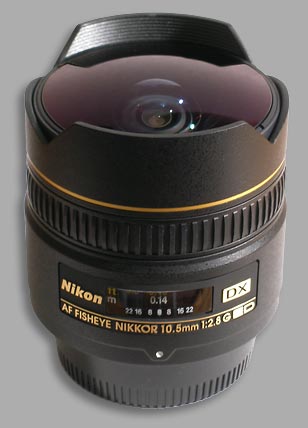
Here's your sign: Gone Fishing. Then pack up your D70 (or other fine digital Nikon) and wrap the world around this little optic. It's the AF Fisheye-Nikkor 10.5mm f/2.8G ED DX lens and it brings corner to corner 180° warped perspective views to the Nikon line of dSLRs. Physically it is quite small. If you are familiar with the Nikkor back caps, you may be able to estimate its size from the photo. In fact, on most monitors, the image here is bigger than the real thing. It sticks out only 63 mm from the front of the lens mount and is 63 mm in diameter--smaller than virtually all other Nikkor lenses usable on the D70, but don't let size fool you. This little jewel is about to become one hot ticket. Nikon calls its coverage "equisolid angle projection," meaning that it bends the world into a sphere that is quite linearly exact, then projects that image onto the camera's sensor chip.
The Fish is sharp. It makes a nice, clean image from corner to corner and closes down to f/22 for depth of field from inches to eternity. Minimum focus distance is about 6 inches (0.14 m) and at f/22 hyperfocal distance is only about 10 inches, so you could shoot with everything 5 inches from the image plane (roughly the surface of the front element) all the way to Orion while maintaining very sharp focus. Filtering a lens like this is nearly impossible, so Nikon figured out a way of inserting gels into a holder behind the lens. Cut a 27mm square of material and lop off 5mm of each corner, then slide it into the holder and you're in business. This means that with a Wratten IR filter you could shoot fisheye infrared pictures. Ooo!
So wouldn't it be cool to have some way of turning those fisheye pictures into the rectilinear perspective photo editors prefer and pay good money for? It turns out that this is not only theoretically possible, but worth doing to images from the 10.5 Fish. Nikon Capture
Magic Well, cool. But Nikon Capture will set you back around a hundred bucks in the USA. Couldn't iNovaFX Labs do something about this? Yes indeed. And the results (right) are likely to blow your socks to Smithereens! Wherever that is. It must be far; I can't find it in the Atlas. The iNovaFX
Connection When the short dimension of the frame was kept, the long dimension of the frame grew into a fantastic 2.5:1 aspect (in its final form). Pictures are not just wide-angle, and not just super wide-angle. In fact, ultra wide-angle isn't even enough of a description. These images are HYPER wide-angle. Roll your mouse over the vertical image and you will see the original 3:2 frame just as the lens captured it. Special iNovaFX Photoshop Actions are already in the "dSLR: Nikon D70 eBook" text and the Actions will be available for owners of the 10.5 Fish the instant the eBook rolls off the assembly line. (Update: ...which is now. It's finished and available today!) An Ultra and Hyper version are included. The Ultra version makes a file 3250 x 1800 pixels. Hyper (above) creates a 3720 x 1486 pixel file. Now that little Fisheye-Nikkor is worth its weight in gold (or $650-ish, whichever comes first). Not only is it a curvilinear lens with fun perspectives, but with the iBCFish-Hyper iNovaFX Action, it shoots rectilinear pictures wider than anything else in digital photography. And we owe it all to equisolidarity. Later... -iNova Speaking of writing, at this hour the latest Nikon eBook, "DSLR: Nikon D40/D40x" is finished, the fourth in the DSLR: Nikon series. You've already had a minor taste of it in the images above that accompany the review. These have gotten real popular, real fast. A huge--and I mean HUGE--amount of data, camera specific special techniques, problem solving procedures, operational short-cuts, headache prescriptions, shot achieving tips, smart camera tricks and Nikon lore you've never seen anywhere else is within their pages. You'll see. Regards, -iNova Photography and artwork on this site by Peter iNova. ©2007 Peter iNova, all rights reserved. |
||
 Not exactly a Review.
More like a Report. But when you read it, you'll be glad you
spent the time and effort.
Not exactly a Review.
More like a Report. But when you read it, you'll be glad you
spent the time and effort.
